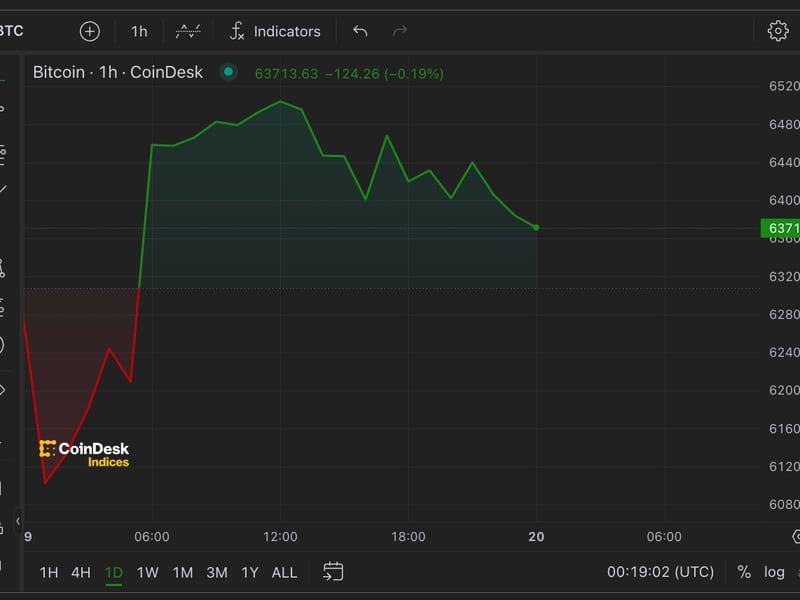Crypto for Advisors: Crypto as a Growth Driver
In today’s issue, Nathan McCauley, co-founder & CEO of Anchorage Digital, explores how crypto could be a growth driver for advisors.
In Ask an Expert, Marissa Kim from Abra Capital Management answers questions advisors may have about including crypto in their practice.

01:16
Bitcoin Nears its First Weekly Chart ‘Death Cross’

15:13
Valkyrie Funds, Ark Invest To Offer Crypto SMAs

01:01
Why Bitcoin’s Bear Market Might Be Coming to a Close
You’re reading Crypto for Advisors, CoinDesk’s weekly newsletter that unpacks digital assets for financial advisors. Subscribe here to get it every Thursday.
Crypto is a Growth Driver for Wealth Managers
For wealth managers, crypto presents a key opportunity for growth – especially with rising mainstream interest after the approval of spot bitcoin and ether exchange-traded funds (ETFs) earlier this year.
As organic growth in wealth management declines and the marketplace becomes more crowded and competitive, crypto can help wealth managers drive client retention and reach new clients with a differentiated offering.
Between the new spot ETFs and separately managed accounts (SMAs), wealth managers have a wide menu of options to offer crypto to their end clients.
ETFs and streamlined adoption
Spot ETFs present a streamlined path for wealth managers to offer crypto, especially for those who use ETF-based model portfolios. In recent months, some of the largest players – from major wealth management firms to Wall Street banks – have allowed advisors to offer crypto ETFs to eligible clients.
The ETF wrapper has unlocked serious latent interest in integrating crypto into traditional portfolios, driving tens of billions of dollars into the digital asset class through a regulated and accessible investment vehicle. Competition amongst ETF issuers in the U.S., in particular, sparked fee compression for these products, benefiting crypto ETF shareholders.
While spot crypto ETFs continue to be a significant unlock across mainstream and institutional finance, there are a few things wealth managers need to keep in mind. First, only SEC-regulated spot ETFs for bitcoin and ether are available on the market today. Like all spot ETFs, these products give shareholders direct exposure to – but not direct ownership of – the underlying asset.
As a result, wealth managers should also consider other complementary avenues for crypto ownership, such as SMAs.
Crypto SMAs as the next evolution
With rising adoption of SMAs across the board and increasing interest in crypto as an asset class, crypto SMAs represent a perfect marriage. By combining direct ownership with professional management, crypto SMAs offer significant benefits for both wealth managers and clients alike.
A qualified custodian serves as the base layer of a compliant crypto SMA. Today, wealth managers can access qualified custodians for crypto through turnkey asset management platforms, third-party technology platforms, and direct integrations. Safekeeping crypto with a qualified custodian gives end clients the regulatory certainty they need to participate in the asset class.
For end clients, crypto SMAs unlock the ability to access a broader range of digital assets – beyond just Bitcoin and Ethereum. The SMA structure also allows for greater flexibility in portfolio construction, which means end clients can deploy more personalized investment strategies. End clients may also benefit from improved tax efficiency.
For wealth managers, what does all of this mean? Greater client choice, which translates into enhanced client retention and differentiation from competitors in the market. By offering crypto SMAs, wealth managers can help future-proof their businesses – while providing the safety, security and regulatory certainty that clients have come to expect.
Embracing crypto through SMAs and complementary vehicles like spot ETFs can help position wealth managers to play a leading role in financial innovation, driving both long-term client satisfaction and business growth.
Ask an Expert
Q: How large of an opportunity does crypto represent? We want to understand how much firm resources we should devote toward gaining knowledge of crypto products.
It is estimated that about 50 million Americans (15%) already own crypto today, which means some of your clients likely already have exposure or are interested in getting exposure. Moreover, the adoption of cryptocurrencies is happening faster than the adoption of the internet, and we believe this participation rate may skyrocket over the next five years so that there will be significant demand from your clients.
As the wealth transfer from Boomers to Millennials occurs over the next five to 20 years, we believe millennials will have greater interest in owning cryptocurrencies and are likely to want to hold those assets directly, versus through ETFs or ETPs. There are still ways for advisors to be value-add to this type of client, but it does require investment of time to learn how clients will want to access these assets and the full breadth of product offerings beyond the ETFs.
Q: Where do digital assets fit into client portfolios from an allocation perspective?
Bitcoin is now being considered by some as a risk asset and as an asset that you would hold in a lower risk, defensive bucket, similar to precious metals or bonds. That being said, many advisors we speak to are only recommending to their clients exposure of 1-5% of total investable net worth to Bitcoin for now.
Assets like Ethereum and Solana are still being considered mostly in a high-risk bucket, more similar to owning single high-growth technology stocks, which can have significant upside as adoption continues but will also continue to be volatile, which may not be suitable for large position sizing or for some types of more conservative investors.
Q: What will happen with the regulatory environment in the U.S. – should we wait to make recommendations until the landscape is more settled?
In general, there is uncertainty in the U.S. around how digital assets should be treated under current law and whether the SEC and/or CFTC have jurisdiction over certain assets. There are many inconsistent approaches from various U.S. agencies and active cases going through the legal system now that are starting to show where the gaps are. There have also been several bipartisan crypto-related bills proposed over the last year.
While the industry certainly needs more regulatory clarity, BTC and ETH have some certainty following the approval of the spot ETFs, which confirmed that these assets are commodities – which is why these assets are likely to see increased institutional adoption.
Keep Reading
-
Bitcoin had a
better-than-usual
September, which has historically been it’s worst month.
Edited by Bradley Keoun.









